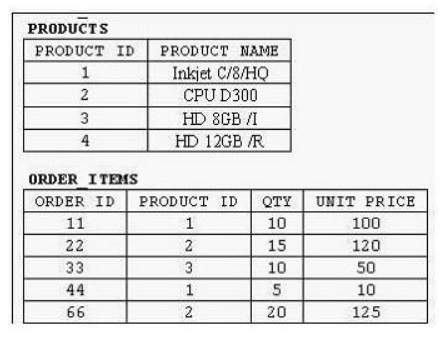Question: 1
View the Exhibit and examine PRODUCTS and ORDER_ITEMS tables.

You executed the following query to display PRODUCT_NAME and the number of times the product has been ordered:
SELECT p.product_name, i.item_cnt
FROM (SELECT product_id, COUNT (*) item_cnt
FROM order_items
GROUP BY product_id) i RIGHT OUTER JOIN products p
ON i.product_id = p.product_id;
What would happen when the above statement is executed?
Question: 2
Which statement is true regarding the UNION operator?
Question: 3
You issued the following command:
SQL> DROP TABLE employees;
Which three statements are true? (Choose three.)
Question: 4
Examine the create table statements for the stores and sales tables.
SQL> CREATE TABLE stores(store_id NUMBER(4) CONSTRAINT store_id_pk PRIMARY KEY, store_name VARCHAR2(12), store_address VARCHAR2(20), start_date DATE);
SQL> CREATE TABLE sales(sales_id NUMBER(4) CONSTRAINT sales_id_pk PRIMARY KEY, item_id NUMBER(4), quantity NUMBER(10), sales_date DATE, store_id NUMBER(4), CONSTRAINT store_id_fk FOREIGN KEY(store_id) REFERENCES stores(store_id));
You executed the following statement:
SQL> DELETE from stores
WHERE store_id=900;
The statement fails due to the integrity constraint error:
ORA-02292: integrity constraint (HR.STORE_ID_FK) violated
Which three options ensure that the statement will execute successfully? (Choose three.)
Question: 5
In the customers table, the CUST_CITY column contains the value 'Paris' for the
CUST_FIRST_NAME 'Abigail'.
Evaluate the following query:

What would be the outcome?